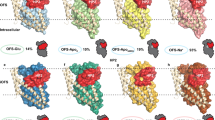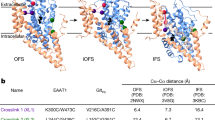Abstract
Neurotransmitter/sodium symporters (NSSs) couple the uptake of neurotransmitter with one or more sodium ions1,2,3, removing neurotransmitter from the synaptic cleft. NSSs are essential to the function of chemical synapses, are associated with multiple neurological diseases and disorders4, and are the targets of therapeutic and illicit drugs5. LeuT, a prokaryotic orthologue of the NSS family, is a model transporter for understanding the relationships between molecular mechanism and atomic structure in a broad range of sodium-dependent and sodium-independent secondary transporters6,7,8,9,10,11,12,13. At present there is a controversy over whether there are one or two high-affinity substrate binding sites in LeuT. The first-reported crystal structure of LeuT, together with subsequent functional and structural studies, provided direct evidence for a single, high-affinity, centrally located substrate-binding site, defined as the S1 site14,15. Recent binding, flux and molecular simulation studies, however, have been interpreted in terms of a model where there are two high-affinity binding sites: the central, S1, site and a second, the S2 site, located within the extracellular vestibule16. Furthermore, it was proposed that the S1 and S2 sites are allosterically coupled such that occupancy of the S2 site is required for the cytoplasmic release of substrate from the S1 site16. Here we address this controversy by performing direct measurement of substrate binding to wild-type LeuT and to S2 site mutants using isothermal titration calorimetry, equilibrium dialysis and scintillation proximity assays. In addition, we perform uptake experiments to determine whether the proposed allosteric coupling between the putative S2 site and the S1 site manifests itself in the kinetics of substrate flux. We conclude that LeuT harbours a single, centrally located, high-affinity substrate-binding site and that transport is well described by a simple, single-substrate kinetic mechanism.
This is a preview of subscription content, access via your institution
Access options
Subscribe to this journal
Receive 51 print issues and online access
$199.00 per year
only $3.90 per issue
Buy this article
- Purchase on Springer Link
- Instant access to full article PDF
Prices may be subject to local taxes which are calculated during checkout




Similar content being viewed by others
References
Abramson, J. & Wright, E. M. Structure and function of Na+-symporters with inverted repeats. Curr. Opin. Struct. Biol. 19, 425–432 (2009)
Krishnamurthy, H., Piscitelli, C. L. & Gouaux, E. Unlocking the molecular secrets of sodium-coupled transporters. Nature 459, 347–355 (2009)
Sobczak, I. & Lolkema, J. S. Structural and mechanistic diversity of secondary transporters. Curr. Opin. Microbiol. 8, 161–167 (2005)
Hahn, M. K. & Blakely, R. D. Monoamine transporter gene structure and polymorphisms in relation to psychiatric and other complex disorders. Pharmacogenomics J. 2, 217–235 (2002)
Amara, S. G. & Sonders, M. S. Neurotransmitter transporters as molecular targets for addictive drugs. Drug Alcohol Depend. 51, 87–96 (1998)
Celik, L., Schiøtt, B. & Tajkhorshid, E. Substrate binding and formation of an occluded state in the leucine transporter. Biophys. J. 94, 1600–1612 (2008)
Rosenberg, A. & Kanner, B. I. The substrates of the gamma-aminobutyric acid transporter GAT-1 induce structural rearrangements around the interface of transmembrane domains 1 and 6. J. Biol. Chem. 283, 14376–14383 (2008)
Vandenberg, R. J., Shaddick, K. & Ju, P. Molecular basis for substrate discrimination by glycine transporters. J. Biol. Chem. 282, 14447–14453 (2007)
Faham, S. et al. The crystal structure of a sodium galactose transporter reveals mechanistic insights into Na+/sugar symport. Science 321, 810–814 (2008)
Weyand, S. et al. Structure and molecular mechanism of a nucleobase-cation-symport-1 family transporter. Science 322, 709–713 (2008)
Shaffer, P. L., Goehring, A., Shankaranarayanan, A. & Gouaux, E. Structure and mechanism of a Na+-independent amino acid transporter. Science 325, 1010–1014 (2009)
Gao, X. et al. Structure and mechanism of an amino acid antiporter. Science 324, 1565–1568 (2009)
Fang, Y. et al. Structure of a prokaryotic virtual proton pump at 3.2 Å resolution. Nature 460, 1040–1043 (2009)
Yamashita, A. et al. Crystal structure of a bacterial homologue of Na+/Cl−-dependent neurotransmitter transporters. Nature 437, 215–223 (2005)
Singh, S. K., Piscitelli, C. L., Yamashita, A. & Gouaux, E. A competitive inhibitor traps LeuT in an open-to-out conformation. Science 322, 1655–1661 (2008)
Shi, L. et al. The mechanism of a neurotransmitter:sodium symporter-inward release of Na+ and substrate is triggered by substrate in a second binding site. Mol. Cell 30, 667–677 (2008)
Christensen, J. J., Hill, J. O. & Izatt, R. M. Ion binding by synthetic macrocyclic compounds. Science 174, 459–467 (1971)
Kawate, T. & Gouaux, E. Fluorescence-detection size-exclusion chromatography for precrystallization screening of integral membrane proteins. Structure 14, 673–681 (2006)
Quick, M. & Javitch, J. A. Monitoring the function of membrane transport proteins in detergent-solubilized form. Proc. Natl Acad. Sci. USA 104, 3603–3608 (2007)
Hansen, S. B. et al. Tryptophan fluorescence reveals conformational changes in the acetylcholine binding protein. J. Biol. Chem. 277, 41299–41302 (2002)
Singh, S. K., Yamashita, A. & Gouaux, E. Antidepressant binding site in a bacterial homologue of neurotransmitter transporters. Nature 448, 952–956 (2007)
Zhou, Z. et al. LeuT-desipramine structure reveals how antidepressants block neurotransmitter uptake. Science 317, 1390–1393 (2007)
Hill, A. V. The combinations of haemoglobin with oxygen and with carbon monoxide. I. Biochem. J. 7, 471–480 (1913)
Segel, I. H. Enzyme Kinetics: Behavior and Analysis of Rapid Equilibrium and Steady-State Enzyme Systems 398–401 (Wiley, 1975)
Wiseman, T., Williston, S., Brandts, J. F. & Lin, L. N. Rapid measurement of binding constants and heats of binding using a new titration calorimeter. Anal. Biochem. 179, 131–137 (1989)
Acknowledgements
We thank T. Pan and R. Hibbs for comments and L. Vaskalis for assistance with figures. C.L.P. was supported by the ARCS foundation and NIH training grant T32 DK007680. This work was supported by the NIH. E.G. is an investigator with the Howard Hughes Medical Institute.
Author information
Authors and Affiliations
Contributions
C.L.P., H.K. and E.G. designed the research; C.L.P. and H.K. performed the research and analyzed the data; and C.L.P., H.K. and E.G. wrote the paper.
Corresponding author
Ethics declarations
Competing interests
The authors declare no competing financial interests.
Supplementary information
Supplementary Information
This file contains Supplementary Figures 1-2 with legends and Supplementary Tables 1-8. (PDF 184 kb)
Rights and permissions
About this article
Cite this article
Piscitelli, C., Krishnamurthy, H. & Gouaux, E. Neurotransmitter/sodium symporter orthologue LeuT has a single high-affinity substrate site. Nature 468, 1129–1132 (2010). https://doi.org/10.1038/nature09581
Received:
Accepted:
Published:
Issue Date:
DOI: https://doi.org/10.1038/nature09581
This article is cited by
-
The Amino Terminus of LeuT Changes Conformation in an Environment Sensitive Manner
Neurochemical Research (2020)
-
The role of interfacial lipids in stabilizing membrane protein oligomers
Nature (2017)
-
Role of Histidine 547 of Human Dopamine Transporter in Molecular Interaction with HIV-1 Tat and Dopamine Uptake
Scientific Reports (2016)
-
Asymmetry in inward- and outward-affinity constant of transport explain unidirectional lysine flux in Saccharomyces cerevisiae
Scientific Reports (2016)
-
Transition metal ion FRET uncovers K+ regulation of a neurotransmitter/sodium symporter
Nature Communications (2016)
Comments
By submitting a comment you agree to abide by our Terms and Community Guidelines. If you find something abusive or that does not comply with our terms or guidelines please flag it as inappropriate.



